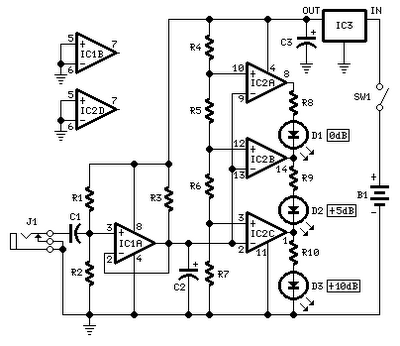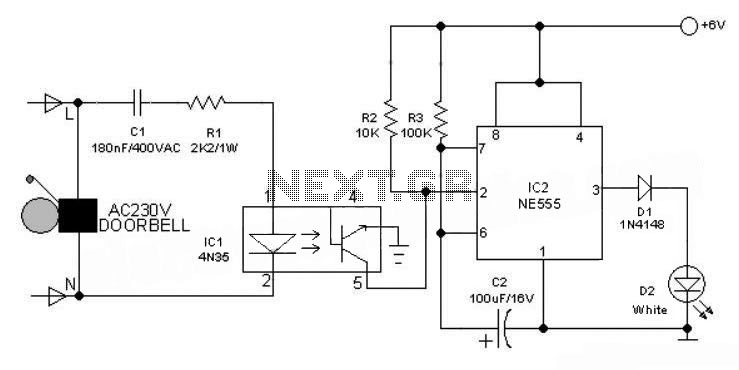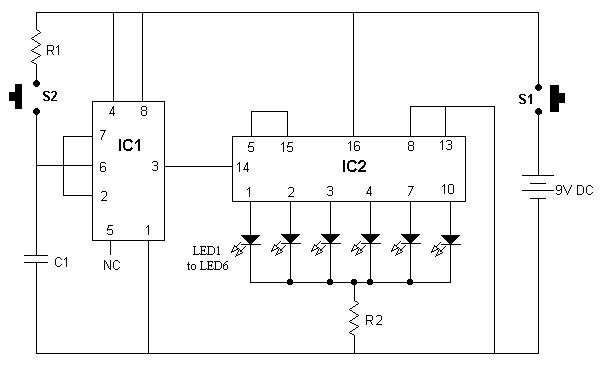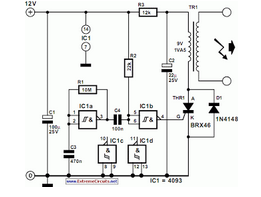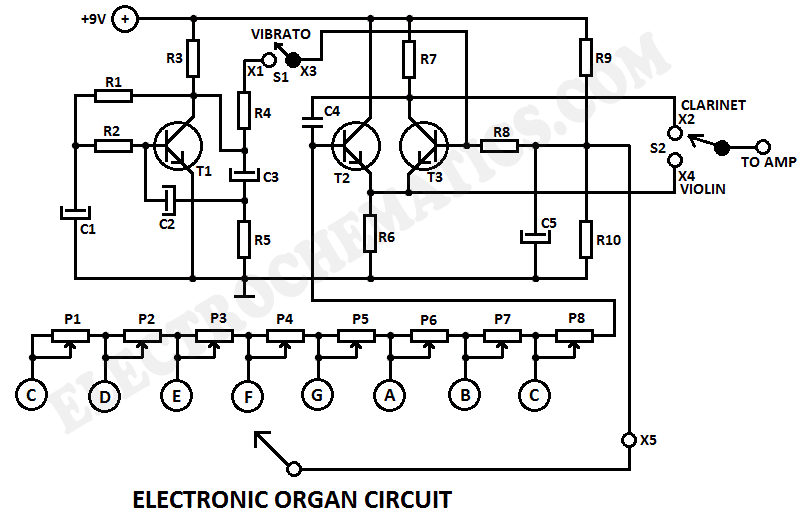
Flooding rats Electronic cat
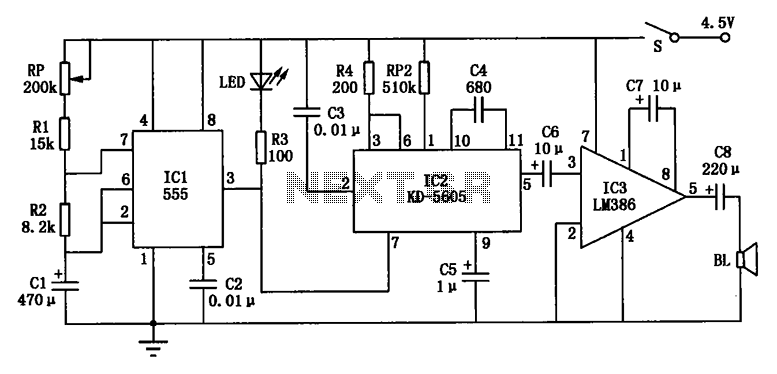
The electronic circuit depicted in Figure cat features the NE555 time base integrated circuit (IC1), along with a potentiometer (RP), resistors (R1 and R2), and a capacitor (C1) that collectively form a time control circuit for regulating intervals. The second integrated circuit (IC2), identified as KD-5605, is designed to emit cat calls within the system. When switch S is closed, power is supplied through RP, R1, and R2 to charge C1. The capacitor C1 charges to two-thirds of the power supply voltage, causing the output pin of IC1 to go low, which activates a light-emitting diode (LED). This indicates that IC2 is operational and generating the cat call output. The output signal from IC2 is amplified by a power amplifier (IC3), which drives a speaker (BL) to produce realistic cat sounds intended for repelling rodents. As IC1 conducts internal discharge, the stored charge in C1 discharges through R2 to the discharge pin of IC1. Once the voltage across C1 drops to one-third of the supply voltage, the output pin of IC1 goes high, turning off the LED and cutting power to IC2, thereby stopping the cat call output. The cycle then repeats as C1 is recharged through RP, R1, and R2.
This circuit operates as a timer that generates periodic cat sounds to deter pests. The NE555 timer is configured in astable mode, allowing it to continuously switch between high and low output states. The timing interval, which dictates how long the LED remains on and how often the cat call is emitted, can be adjusted by changing the values of the resistors R1, R2, and the capacitor C1. The potentiometer RP allows for fine-tuning of the charging time, thus influencing the overall frequency of the output sound.
The KD-5605 integrated circuit is a sound generator that produces the desired cat call sound. Its output is connected to a power amplifier (IC3), which boosts the signal to drive a speaker (BL). This amplification is crucial for ensuring that the sound is loud enough to be effective in scaring away rodents.
The feedback loop created by the charging and discharging of capacitor C1 is essential for the continuous operation of the circuit. The internal discharge of the NE555 timer ensures that the capacitor discharges fully, allowing for a consistent timing cycle. This self-sustaining mechanism is what makes the circuit efficient for long-term operation without the need for constant manual intervention.
In summary, this electronic circuit effectively combines a timer, sound generation, and amplification to create a pest deterrent system that is both practical and adjustable based on the user's requirements. The design is straightforward, making it suitable for various applications where pest control is necessary.Electronic circuit shown in Figure cat. ICl time base integrated circuit NE555, it potentiometer RP, resistor Rl, R2 and capacitor Cl form time control circuit for controlling mew interval. IC2 is mew IC KD-5605, it will cure the cat calls within the circuit. Closing the switch S, the power by RP, Rl, R2 to charge Cl, Cl charge to the voltage across the power supply voltage 2/3, pin output low ICl, a light emitting diode LED powered light, while IC2 electrical work, after the output signal is a cat called IC3 power amplifier push speaker BL loud realistic mew, to drive rats purposes. At the same time, ICl internal discharge conduction, Cl stored charge through R2 to IC1 foot discharge.
When the supply voltage drops the voltage across Cl l/3 ±, ICl the pin output high, LED is off, IC2 also lost power to stop working, stop mew. Power and to charge C1 through RP, Rl, R2, circuit so the cycle work.
This circuit operates as a timer that generates periodic cat sounds to deter pests. The NE555 timer is configured in astable mode, allowing it to continuously switch between high and low output states. The timing interval, which dictates how long the LED remains on and how often the cat call is emitted, can be adjusted by changing the values of the resistors R1, R2, and the capacitor C1. The potentiometer RP allows for fine-tuning of the charging time, thus influencing the overall frequency of the output sound.
The KD-5605 integrated circuit is a sound generator that produces the desired cat call sound. Its output is connected to a power amplifier (IC3), which boosts the signal to drive a speaker (BL). This amplification is crucial for ensuring that the sound is loud enough to be effective in scaring away rodents.
The feedback loop created by the charging and discharging of capacitor C1 is essential for the continuous operation of the circuit. The internal discharge of the NE555 timer ensures that the capacitor discharges fully, allowing for a consistent timing cycle. This self-sustaining mechanism is what makes the circuit efficient for long-term operation without the need for constant manual intervention.
In summary, this electronic circuit effectively combines a timer, sound generation, and amplification to create a pest deterrent system that is both practical and adjustable based on the user's requirements. The design is straightforward, making it suitable for various applications where pest control is necessary.Electronic circuit shown in Figure cat. ICl time base integrated circuit NE555, it potentiometer RP, resistor Rl, R2 and capacitor Cl form time control circuit for controlling mew interval. IC2 is mew IC KD-5605, it will cure the cat calls within the circuit. Closing the switch S, the power by RP, Rl, R2 to charge Cl, Cl charge to the voltage across the power supply voltage 2/3, pin output low ICl, a light emitting diode LED powered light, while IC2 electrical work, after the output signal is a cat called IC3 power amplifier push speaker BL loud realistic mew, to drive rats purposes. At the same time, ICl internal discharge conduction, Cl stored charge through R2 to IC1 foot discharge.
When the supply voltage drops the voltage across Cl l/3 ±, ICl the pin output high, LED is off, IC2 also lost power to stop working, stop mew. Power and to charge C1 through RP, Rl, R2, circuit so the cycle work.
